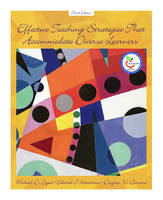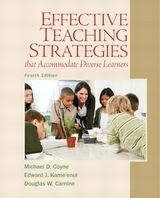
Effective Teaching Strategies that Accommodate Diverse Learners
Pearson (Verlag)
978-0-13-172022-0 (ISBN)
- Titel erscheint in neuer Auflage
- Artikel merken
FEATURES:
Includes new "application and reflection" sections in each chapter that provide applied case studies, application activities, and questions for discussion and reflection-This new feature allows students to apply the six principles of effective instruction to real life situations, with the goal of facilitating the translation of research to practice.
Includes a new chapter on teaching reading comprehension-With the addition of this new chapter, the book now better covers the complexities of teaching reading with chapters on both teaching code-based elements of reading such as phonemic awareness, alphabetic understanding, and fluency as well as teaching meaning-based elements of reading such as comprehension strategies.
Provides recommendations for determining the critical curricular and instructional priorities for teaching students with diverse learning needs, who are typically behind their school-age peers in academic performace and content coverage.
Concrete examples of how key concepts in reading, writing, mathematics, science, and social studies are taught, integrated, and supported-Examples are provided across grade levels, from the elementary grades through high school.
Guidelines for developing, selecting, and modifying curricula to meet the needs of diverse learners into each chapter.
Chapter 1 Introduction
A Retrospective of Educational Innovations
Reading Innovations
Mathematics Innovations
Social Studies Innovations
Science Education Innovations
The Purpose of This Book
Features of High-Quality Educational Tools
Big Ideas
Conspicuous Strategies
Mediated Scaffolding
Strategic Integration
Primed Background Knowledge
Judicious Review
Benefits of Instruction Based on Quality Design Tools
The Application of Instructional Design Principles
Developing Effective Instructional Tools
Selecting Instructional Tools
Modifying Instructional Tools
Summary
References
Chapter 2 Characteristics of Students with Diverse Learning and Curricular Needs
A Demographic Portrait of Diversity
Learner Characteristics
Retaining Information
Learning Strategies
Vocabulary Knowledge
Language Coding
Summary
References
Chapter 3 Modulating Instruction for English Language Learners
Problems in Current Instruction of English Language Learners
Differing Theories About and Approaches to Second Language Instruction
Constructs for Conceptualizing Effective Instructional Practice
Scenario One: Merging Language Learning with Reading Instruction
Scenario Two: Building Intellectual Accountability During Literacy Instruction
Scenario Three: Accessing First Language Knowledge During Literacy Instruction
Scenario Four: Integrating Responsiveness to Cultural and Personal Diversity into Literacy Instruction
Summary
References
Chapter 4 Effective Strategies for Teaching Beginning Reading
Current Issues in Beginning Reading
Research on Beginning Reading
Principles for Improving Instructional Strategies
Beginning Reading: Designing Instruction Around Big Ideas
Designing Mediated Scaffolding
Designing Strategic Integration
Designing Primed Background Knowledge
Designing Judicious Review
The Application of Instructional Design Principles
Developing Instructional Tools
Selecting Instructional Tools
Modifying Instructional Tools
Summary
Effective Teaching Vignette
References
Chapter 5 Effective Strategies for Teaching Reading Comprehension
Current Issues in Reading Comprehension
The Role of Decoding in Comprehension Development
Strategy Instruction versus Content Knowledge
Big Ideas in Reading Comprehension
Fluency
Vocabulary Knowledge
Strategic Processing
Text Features
Conspicuous Strategies
Mediated Scaffolding
Strategic Integration
Primed Background Knowledge
Judicious Review
The Application of Instructional Design Principals
Developing Instructional Tools
Modifying Instructional Tools
Summary
Effective Teaching Vignette
References
Chapter 6 Effective Strategies for Teaching Writing
Current Issues in Writing Instruction
Opportunity to Learn
Author versus Secretary, or Author and Secretary
Technology
Writing Assessment
Principles for Improving Instructional Strategies for Writing
Designing Instruction Around Big Ideas
Summary
References
Chapter 7 Effective Strategies for Teaching Mathematics
Principles for Improving Math Instruction Strategies
Designing Instruction Around Big Ideas
Designing Conspicuous Strategies
Designing Primed Background Knowledge
Designing Strategic Integration
The Application of Instructional Design Principles
Developing Instructional Tools
Selecting Instructional Tools
Modifying Instructional Tools
Summary
Effective Teaching Vignette
References
Chapter 8 Effective Strategies for Teaching Science
Current Issues in Science Instruction
Principles for Improving Instructional Strategies in Science
Designing Instruction Around Big Ideas in Science Inquiry
Components of Science Inquiry
Designing Conspicuous Strategies in Science Inquiry
Designing Instruction Around Big Ideas in Science Subject Matter
Components in Science Subject Matter
Designing Conspicuous Strategies in Science Subject Matter
Designing Mediated Scaffolding in Science Inquiry and Subject Matter Instruction
Designing Judicious Review
Designing Strategic Integration
The Application of Instructional Design Principles
Developing Instructional Tools
Selecting Instructional Tools
Modifying Instructional Tools
Summary
Effectiv Effective Teaching Vignette
References
Chapter 9 Effective Strategies for Teaching Social Studies
Current Issues in Social Studies Instruction
Principles for Improving Instructional Strategies in Social Studies
Designing Instruction Around Big Ideas
Designing Conspicuous Strategies
Designing Mediated Scaffolding
Designing Strategic Integration
Designing Primed Background Knowledge
Designing Judicious Review
The Application of Instructional Design Principles
Developing Instructional Tools
Selecting Instructional Tools
Modifying Instructional Tools
Summary
Effective Teaching Vignette
References
Appendix A Answers to Effective Teaching Vignettes
Appendix B Curriculum Maps for Grades K-3 for Phonological Awareness, Alphabetic Principle, and Spelling
Appendix C Author Note
| Erscheint lt. Verlag | 25.10.2006 |
|---|---|
| Sprache | englisch |
| Gewicht | 454 g |
| Themenwelt | Sozialwissenschaften ► Pädagogik |
| ISBN-10 | 0-13-172022-8 / 0131720228 |
| ISBN-13 | 978-0-13-172022-0 / 9780131720220 |
| Zustand | Neuware |
| Informationen gemäß Produktsicherheitsverordnung (GPSR) | |
| Haben Sie eine Frage zum Produkt? |
aus dem Bereich



